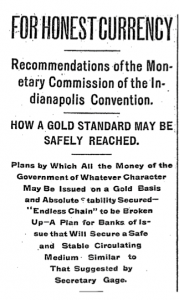Originally posted on Tuesday, April 23, 2013
The groundwork for the Gold Standard Act of 1900, championed by and signed into law by President McKinley, was established by the almost forgotten but, in its time, very prominent Monetary Commission of a body called “The Indianapolis Convention.” As reported by the New York Times:
The report of its findings was prominently featured in The New York Times, headlined FOR HONEST CURRENCY — Recommendations of the Monetary Commission of the Indianapolis Convention — HOW A GOLD STANDARD MAY BE SAFELY REACHED. — Plans by Which All the Money of the Government of Whatever Character May Be Issued on a Gold Basis and Absolute Stability Secured ….

Datelined January 2 (1898): “The report of the Monetary Commission appointed at the Indianapolis Convention of January, 1897, has been prepared and submitted to the Executive Committee of that convention. This report points out in detail the deplorable condition of affairs in this country to-day, explains in language that can be readily understood the shortcomings of our whole monetary and currency system, and offers a plan by which a gold standard can be reached without injury to any interest, and offers suggestions as to changes that seem necessary to our National banking system, particularly as regards banks of issue and the establishment of banks with small capital in centres of limited population.”
A blog post on The Burning Platform offers a version the backstory:
Monetary reform in the guise of the Indianapolis Monetary Convention of January 12, 1897 promised to find an answer.
The alleged grassroots movement of midwestern businessmen, with behind-the-scenes advice from banking interests, particularly the J.P. Morgan faction, petitioned President McKinley to appoint a presidential commission to craft legislation for a national monetary reform bill. This effort produced a bill which passed in the House but died an ignominious death in the Senate.
Snatching a potential victory from the jaws of that defeat, the secretary of the Indianapolis executive committee, George Foster Peabody, appointed the group’s own commission. Peabody, of an elite Boston family and an investment banker, had picked influential bankers, high-powered businessmen, people having railroad interests, and academics. Funding for the commission came from the banking and corporate world and included J.P. Morgan personally.
Their first major effort was a detailed monetary questionnaire sent to hundreds of chosen experts. Selected portions of the document were sent to newspapers throughout the country.
This public relations effort and other measures to form public opinion reached over 7,000 newspapers, along with support through letters from prominent businessmen and a large cadre of organized partisans. The goal of affirming the monometallism gold standard ended the influence of the Bryan and Populist believers of free silver.
Lobbying in Washington, led by Mark Hanna, McKinley’s “brain” and manager of his campaigns of 1896 and 1900, left no stone unturned. Hanna also urged a public letter-writing effort in support of a proposed reform bill.
The Monetary Commission met in Washington on September 22, 1897 and worked into December to produce a preliminary report:
REPORT OF THE MONETARY COMMISSION TO THE EXECUTIVE COMMITTEE OF THE INDIANAPOLIS MONETARY CONVENTION
and quoting the resolution establishing the committee
that it has become absolutely necessary that a consistent, straightforward and deliberately-planned monetary system shall be inaugurated, the fundamental basis of which should be: first, that the present gold standard should be maintained; second, that steps should be taken to insure the ultimate retirement of all classes of United States notes by a gradual and steady process, and so as to avoid injurious contraction of the currency or disturbance of the business interests of the country, and that until such retirements provision should be made for a separation of the revenue and note-issue departments of the Treasury; third, that a banking system be provided which should furnish credit facilities to every portion of the country and a safe and elastic circulation, and especially with a view of securing such a distribution of the loanable capital of the country as will tend to equalize the rates of interest in all parts thereof.
By now, enough public relations schemes had influenced the people. A second convention in Indianapolis in early 1898 included nearly 500 delegates from 31 states – and a thorough sampling of the nation’s corporate leaders. Bankers were included and academic economists, also.
The second convention approved of the monetary commission work on January 26, 1898 and requested a final report of greater detail. This was finished and printed for distribution in June 1898. Improvements included a broader currency base – and specifically, a central bank with sole authority to issue bank notes.

Recent Comments